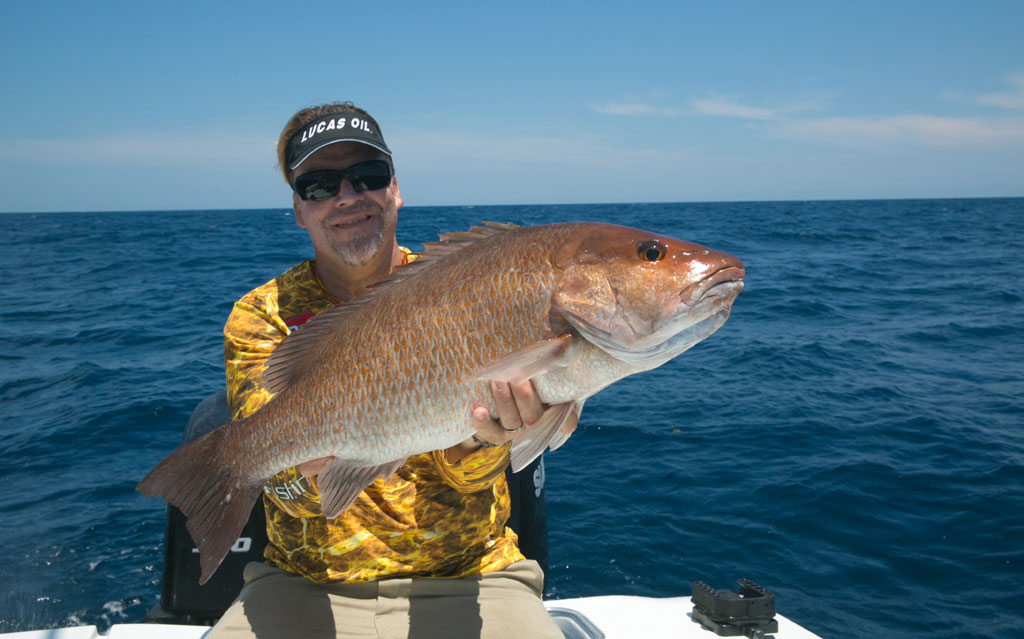with Mark Davis

Fish in different regions often get renamed by local anglers, and because the mangrove snapper is so prevalent in the Florida mangroves, this snapper is known throughout most of the South as a mangrove snapper. However, its real name is a gray snapper. This fish is called by both names, depending on where you catch this fish and the people with whom you’re fishing.
In my early fishing days, I worked on a party boat, often called by anglers a head boat, in my home state of South Carolina. We took 80 people each day out fishing, but we never caught more than a half dozen mangrove snapper for the entire season. So, I knew what a mangrove snapper looked like, and I understood what it felt like when a mangrove snapper bit a bait.
I was fishing one time out of Ocean Isle Beach in North Carolina, filming for my TV show “BigWater Adventures.” The biggest mangrove snapper I ever caught was there. At that time, mangrove snapper were so rare in North Carolina that the state didn’t even have a state record established for that species. The week before, I’d been in Texas filming a TV show on catching American red snapper and mangrove snapper.
When my TV crew and I are fishing, we play a game that as soon as a fish bites, the angler says, “I’ll betcha that’s a _____.” Everyone on the boat will bet $1 - $5 each on whether or not the angler who’s just gotten a bite from a fish and hooked has named the fish correctly. The week before our North Carolina trip while in Texas, I’d learned what an American red snapper bite and a mangrove snapper bite felt like. On this North Carolina trip, we were fishing for ground (bottom) fish in 150 feet of water. As soon as I got the bite, I looked at Captain Steve Montgomery, and said, “This bite feels like a 10-pound mangrove snapper.” Captain Montgomery replied, “If that’s a 10-pound mangrove snapper, you’ve just caught the North Carolina mangrove snapper state record.”
Once I got the fish to the surface, it was a 12.5 pound mangrove snapper and still today is the current state record after being weighed and certified. One of the even more unique aspects of this catch was that Captain Montgomery called the marine biologist and told him we were bringing in a 12-plus pound mangrove snapper. So, the biologist met us at the dock and said, “This probably isn’t a mangrove snapper but rather is a cubera snapper.” Captain Montgomery told the biologist, “The guy who caught this fish is adamant that this is a mangrove snapper. He’s fished all over the world and has caught a large number of cubera snapper as well as mangroves. He knows mangrove snapper.” The biologist eventually certified my fish as the North Carolina state record mangrove snapper.
Venice, Louisiana, is blessed with large numbers of large-sized mangrove snapper, and we’ve caught and released plenty of them before. In Venice, we fish short rigs using 50-pound-test Seaguar fluorocarbon as a leader tied to 50-pound test Seaguar braided line with 7-foot rods with fairly fast action. The average mangrove snapper in Louisiana may weigh 8-12 pounds. They attack the bait like a grouper and run back toward the rig. We were using 6-7-inch-long menhaden to catch the bigger mangrove snapper. The smaller mangrove snapper will eat shrimp, but like many other fish, to catch the bigger ones, you have to use bigger baits. We fished with a circle hook with about a 1-ounce weight to get the menhaden down to the mangrove snapper. We had the weight about 18 inches above the fluorocarbon leader and used a slip float that we set from 6-15 feet deep on a rig that stood on a 60-foot bottom.
The mangrove snapper usually would be suspended up off the bottom on the rig’s side. You tried to cast as closely to the rig as possible and still have time to set the hook and turn the mangrove’s head away from the rig before the fish could dive into the rig. A good mangrove on these rigs will weigh 13-15 pounds, and some bigger ones are caught occasionally. I believe the biggest mangrove snapper in the world probably are caught in Louisiana and Texas.
Snapper is a delicious fish, so if you get your hands on some, try this recipe.



























